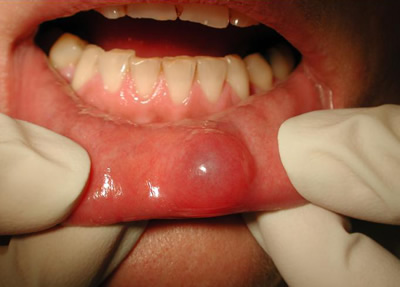Lumps and Bumps in the Mouth and Salivary Glands

There are many causes of benign (non-harmful) lumps occurring in the mouth.
Fibroepithelial polyps often develop in sites of trauma most commonly on the cheek or side of the tongue. These may easily be removed if necessary.
Papillomas (wart-like growths) also commonly occur in the mouth and may easily be removed.
A mucocele may give rise to a swelling, usually in the lower lip, due to damage to a minor salivary gland usually due to biting the lip. These may easily be removed.
Many patients have bony lumps called exostoses or tori. These occur most commonly on the palate and the inside of the lower jaw. They are easily diagnosed clinically and can usually be left alone.
Swelling of the salivary glands may be due to a stone which typically causes a swelling of the salivary gland at mealtimes or due to systemic diseases such as mumps or Sjogren's syndrome which may cause swelling in multiple salivary glands. Tumours may form in salivary glands and would usually present as a slowly enlarging lump in the salivary gland. Salivary gland tumours may also present in the upper lip, palate and other sites as a slowly enlarging lump. Ultrasound is often useful to diagnose causes of swellings in the salivary glands. Sometimes blood tests and other investigations may be suggested.
Oral cancer may present as a swelling in the mouth. The higher risk sites are the sides of the tongue and the floor of the mouth, under the tongue. Oral cancer most commonly occurs in patients who smoke, drink alcohol or chew pan, although are increasingly seen in young adults without these risk factors. Any unexplained swelling in the mouth should be checked by an oral healthcare professional and a biopsy performed if necessary.